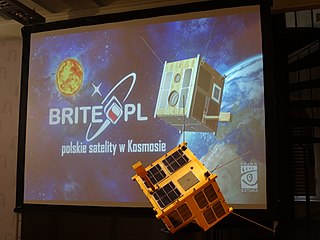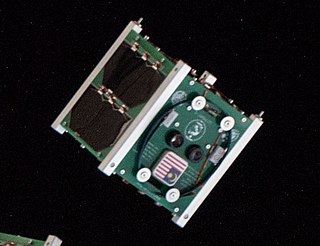
A CubeSat is a class of small satellite with a form factor of 10 cm (3.9 in) cubes. CubeSats have a mass of no more than 2 kg (4.4 lb) per unit, and often use commercial off-the-shelf (COTS) components for their electronics and structure. CubeSats are deployed into orbit from the International Space Station, or launched as secondary payloads on a launch vehicle. As of December 2023, more than 2,300 CubeSats have been launched.

For the DNA sequencesee Microsatellite
Surrey Satellite Technology Ltd, or SSTL, is a company involved in the manufacture and operation of small satellites. A spin-off company of the University of Surrey, it is presently wholly owned by Airbus Defence and Space.
The Space Test Program (STP) is the primary provider of spaceflight for the United States Department of Defense (DoD) space science and technology community. STP is managed by a group within the Advanced Systems and Development Directorate, a directorate of the Space and Missile Systems Center of the United States Space Force. STP provides spaceflight via the International Space Station (ISS), piggybacks, secondary payloads and dedicated launch services.
The Canadian Advanced Nanospace eXperiment (CanX) program is a Canadian CubeSat nanosatellite program operated by the University of Toronto Institute for Aerospace Studies, Space Flight Laboratory (UTIAS/SFL). The program's objectives are to involve graduate students in the process of spaceflight development, and to provide low-cost access to space for scientific research and the testing of nanoscale devices. The CanX projects include CanX-1, CanX-2, the BRIght Target Explorer (BRITE), and CanX-4&5.
The Nanosatellite Launch System (NLS) is a series of satellite launch missions launched 2003–2010, coordinated by the Space Flight Laboratory (SFL) of the University of Toronto Institute for Aerospace Studies (UTIAS).
SNAP-1 is a British nanosatellite in low Earth orbit. The satellite was built at the Surrey Space Centre by Surrey Satellite Technology Ltd (SSTL) and members of the University of Surrey. It was launched on 28 June 2000 on board a Kosmos-3M rocket from the Plesetsk Cosmodrome in northern Russia. It shared the launch with a Russian Nadezhda search and relay spacecraft and the Chinese Tsinghua-1 microsatellite.

SARAL is a cooperative altimetry technology mission of Indian Space Research Organisation (ISRO) and Centre National d'Études Spatiales (CNES). SARAL performs altimetric measurements designed to study ocean circulation and sea surface elevation.
PW-Sat is a series of Polish CubeSats designed and built by students at the Warsaw University of Technology in conjunction with the Faculty of Power and Aeronautical Engineering of Warsaw University of Technology, the Space Research Centre of Polish Academy of Sciences, and the European Space Agency. As of January 1, 2024, there have been 2 PW-Sats with a third in development. The first PW-Sat was the first Polish artificial satellite which was launched 13 February 2012 from ELA-1 at Guiana Space Centre aboard Italian-built Vega launch vehicle during its maiden voyage. After their graduation, the team that developed the original PW-Sat have also worked to develop the subsequent missions, establishing a private company named PW-Sat to design and manufacturer the PW-Sats, all of which test novel deorbiting methods, with the overall goal of the program to develop solutions to space debris.
TUGSAT-1, also known as BRITE-Austria and CanX-3B, is the first Austrian satellite. It is an optical astronomy spacecraft operated by the Graz University of Technology as part of the international BRIght-star Target Explorer programme.
UniBRITE-1 is, along with TUGSAT-1, one of the first two Austrian satellites to be launched. Along with TUGSAT, it operates as part of the BRIght Target Explorer constellation of satellites. The two spacecraft were launched aboard the same rocket, an Indian PSLV-CA, in February 2013. UniBRITE is an optical astronomy spacecraft operated by the University of Vienna as part of the BRIght Target Explorer programme.
Sapphire is a Canadian space surveillance satellite which was launched in 2013. Sapphire was commissioned and integrated by MacDonald, Dettwiler and Associates (MDA) based on an SSTL-150 bus produced by Surrey Satellite Technology (SSTL) and an optical payload produced by COM DEV International.

PhoneSat is an ongoing NASA project of building nanosatellites using unmodified consumer-grade off-the-shelf smartphones and Arduino platform and launching them into Low Earth Orbit. This project is part of NASA's Small Spacecraft Technology Program and was started in 2009 at NASA Ames Research Center.

BRITE-Constellation is an ongoing space mission carrying out two-band photometry in wide fields with a constellation of six BRIght Target Explorer (BRITE) nanosatellites. The mission was built by a consortium of three countries, Canada, Austria, and Poland, each operating two BRITE satellites. The six satellites were launched into low-Earth orbits between February 2013 and August 2014. Each satellite is a cube-shaped spacecraft with sides of 20 centimetres (7.9 in) hosting an optical telescope of 3 centimetres (1.2 in) aperture feeding an uncooled CCD with a field of view of approximately 20° × 24°. The satellites were intended for photometry of the brightest stars in single passband located in the blue or red part of the optical range.

Lem is the first Polish governmental artificial satellite. It was launched in November 2013 as part of the Bright-star Target Explorer (BRITE) programme. The spacecraft was launched aboard a Dnepr rocket. Named after the Polish science fiction writer Stanisław Lem, it is an optical astronomy spacecraft built by the Space Research Centre of the Polish Academy of Sciences and operated by Centrum Astronomiczne im. Mikołaja Kopernika PAN; one of two Polish contributions to the BRITE constellation along with the Heweliusz satellite.

The Polish Space Agency is the space agency of Poland, administered by the Ministry of Economic Development and Technology. It is a member of the European Space Agency. The agency is focused on developing satellite networks and space technologies in Poland. It was established on 26 September 2014, and its headquarters are located in Gdańsk, Poland.
NanoAvionics Corp is a small satellite bus manufacturer and mission integrator founded as a spin-off from Vilnius University, Lithuania in 2014.

ASTERIA was a miniaturized space telescope technology demonstration and opportunistic science mission to conduct astrophysical measurements using a CubeSat. It was designed in collaboration between the Massachusetts Institute of Technology (MIT) and NASA's Jet Propulsion Laboratory. ASTERIA was the first JPL-built CubeSat to have been successfully operated in space. Originally envisioned as a project for training early career scientists and engineers, ASTERIA's technical goal was to achieve arcsecond-level line-of-sight pointing error and highly stable focal plane temperature control. These technologies are important for precision photometry, i.e., the measurement of stellar brightness over time. Precision photometry, in turn, provides a way to study stellar activity, transiting exoplanets, and other astrophysical phenomena.

UiTMSAT-1 was a Malaysian nanosatellite, built primarily by Universiti Teknologi MARA (UiTM) as part of the multi-nation Birds-2 project. The 1U CubeSat was launched into space on 29 June 2018 and deployed from the International Space Station (ISS) on 10 August 2018.
SatRev S.A. is a Polish aerospace company established in 2016, that specialises in building small, lightweight, nanosatellites. The company was listed in the NASA's "State of the Art Small Spacecraft Technology" report as one of 12 in the world.









